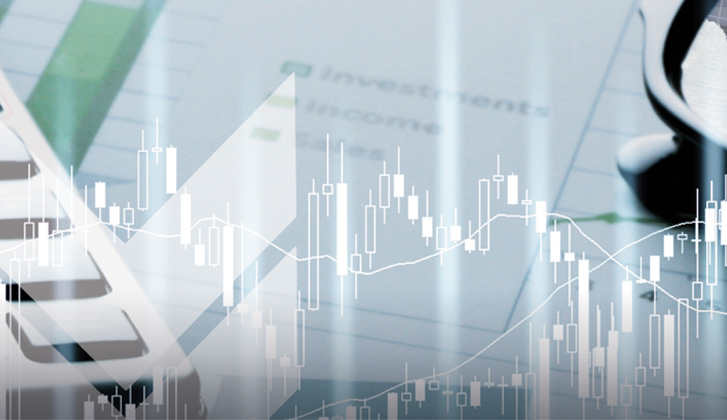NOTICE: Internet Explorer was retired by Microsoft on June 15th, 2022 and is no longer supported. This could change how you access Online Banking.
The Fundamentals of Business Forecasting

What conditions will affect your revenue and cash flow? How should you allocate your resources? Which goals should take priority?
These are just a few of the questions business owners face when planning for the future. Fluctuations in the economy, your industry, and your local market can make it difficult to predict your performance. But knowing the fundamentals of business forecasting can help you see the bigger picture, set realistic expectations, and make better decisions as you move forward. Before you can start forecasting, you need to understand how it works.
It’s More Than Guesswork
An effective business forecast is based on realistic assumptions and careful analysis of trends and patterns. For example, if you’re forecasting the first-year revenue from a new service or product line, you won’t have existing revenue data to draw from. Instead, you’ll need to look for comparable situations.
Consider how another service or product line performed in its first year. You can research the performance of products from similarly sized competitors or look at the market demand for your new offering. Adjusting your forecast over time can help you identify which types of information are most helpful.
Weighing Revenue and Expenses
As you develop and fine-tune your forecast, be sure to address these interconnected areas:
- Sales activity: Depending on your industry, sales activity may depend on your number of sales reps, number of qualified leads, promotional efforts, expectations for distributors, inventory in retail stores, and seasonal trends that affect demand.
- Sales costs: Consider how sales activity influences your costs. Tally the cost of commissions, fees, supplies, and software, among other things.
- Recurring expenses: Your forecast should anticipate recurring expenses related to your staff size, payroll and benefits, facility and equipment costs, and marketing expenses.
By considering the influence of these key factors, your forecast can provide a more accurate view of the new product or service line’s potential.
10 Benefits of Forecasting
A practical business forecast can give you a clearer picture of your needs, opportunities, and risks. This information can help you to:
- Control expenses: Looking at expenses over a longer timeline can help you determine when to hire a new employee or make a big purchase to upgrade your company. It can show you where you can trim costs each month and streamline your budget.
- Project cash flow: Cash flow is the lifeblood of any business. Your forecast can help you manage your cash reserves and understand your outside financing needs, so you can avoid getting caught short.
- Qualify for new credit opportunities: If you apply for a new loan or line of credit, a forecasting report may strengthen your submission. Effective forecasts can also help you to predict and deliver on-time payments.
- Increase customer satisfaction: By forecasting demand, you can provide your customers what they want when they want it. Examine your sales records and look for seasonal or cyclical trends as well as opportunities for achieving revenue efficiency through cross-selling and upselling.
- Optimize staffing: Effective demand forecasting can enable you to build a workforce that’s lean and cost-effective without leading to employee shortages and burnout during your busiest times.
- Prepare for taxes: Taxes are one of the few certainties in business, but many small business owners get blindsided by big tax bills that they don’t have the cash for. Careful cash flow forecasting can help you avoid an unpleasant surprise at the end of the year.
- Reduce supply chain issues: Product demand forecasting has always been essential for businesses that buy from long-lead-time suppliers. But we’ve learned in recent years that just about any supply chain can suffer slowdowns – making forecasting all the more important for every product-based business. Service-based businesses should look into the future to prevent bottlenecks when work may stall; that can help you maintain good relationships with customers.
- Identify areas for improvement: When your forecast falls short, you can use the experience as an opportunity to identify and address the underperforming aspects of your company.
- Discover growth opportunities: When demand increases for a specific product or service and you have a projection to compare it to, you’re able to make quick adjustments to maximize profitability. Forecast data can also help you see whitespace in your industry and develop long-term strategies to address those unmet needs.
- Foster teamwork and good leadership: Business owners and employees alike are apt to get stuck in the day-to-day grind. The forecasting process will require your entire team to take a forward view and work together toward common goals.
Once you’ve developed your forecast, consult it often and adjust your projections as circumstances change. By taking time to learn why some predictions proved correct and others did not, you can learn ways to improve the accuracy of each forecast.
Reach Higher
Consult your financial institution for more tips on making the most of your business.
Content is for informational purposes only and is not intended to provide legal or financial advice. The views and opinions expressed do not necessarily represent the views and opinions of WesBanco.
While we hope you find this content useful, it is only intended to serve as a starting point. Your next step is to speak with a qualified, licensed professional who can provide advice tailored to your individual circumstances. Nothing in this article, nor in any associated resources, should be construed as financial or legal advice. Furthermore, while we have made good faith efforts to ensure that the information presented was correct as of the date the content was prepared, we are unable to guarantee that it remains accurate today.
Neither Strategy Academy nor its sponsoring partners make any warranties or representations as to the accuracy, applicability, completeness, or suitability for any particular purpose of the information contained herein. Strategy Academy and its sponsoring partners expressly disclaim any liability arising from the use or misuse of these materials and, by visiting this site, you agree to release Strategy Academy and its sponsoring partners from any such liability. Do not rely upon the information provided in this content when making decisions regarding financial or legal matters without first consulting with a qualified, licensed professional.



